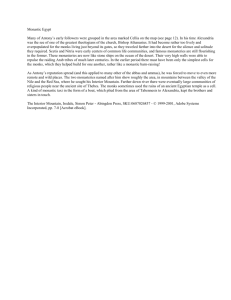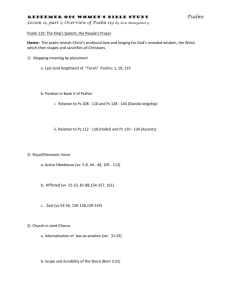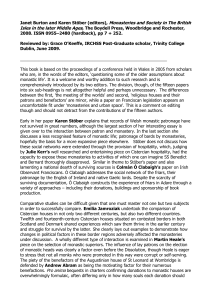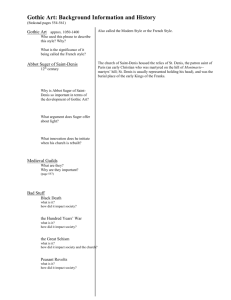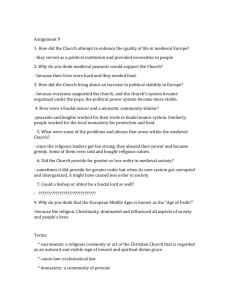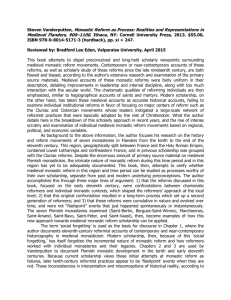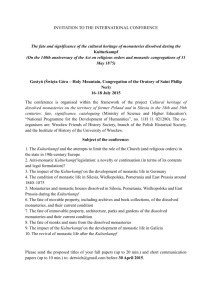View Syllabus - ObieMAPS
advertisement
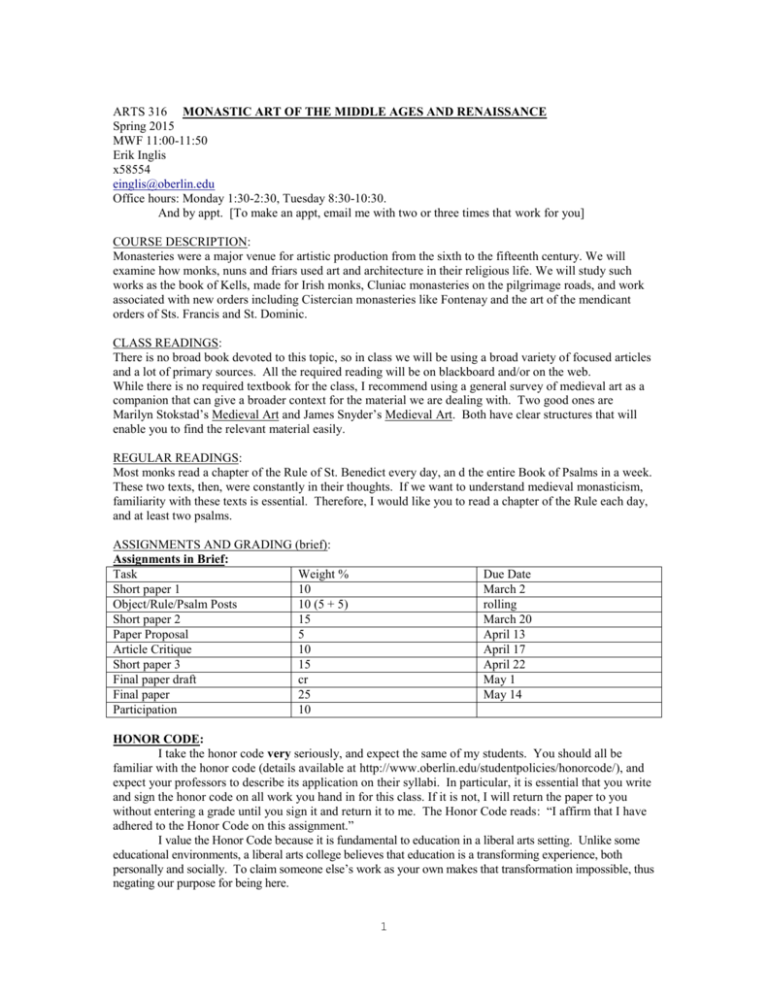
ARTS 316 MONASTIC ART OF THE MIDDLE AGES AND RENAISSANCE Spring 2015 MWF 11:00-11:50 Erik Inglis x58554 einglis@oberlin.edu Office hours: Monday 1:30-2:30, Tuesday 8:30-10:30. And by appt. [To make an appt, email me with two or three times that work for you] COURSE DESCRIPTION: Monasteries were a major venue for artistic production from the sixth to the fifteenth century. We will examine how monks, nuns and friars used art and architecture in their religious life. We will study such works as the book of Kells, made for Irish monks, Cluniac monasteries on the pilgrimage roads, and work associated with new orders including Cistercian monasteries like Fontenay and the art of the mendicant orders of Sts. Francis and St. Dominic. CLASS READINGS: There is no broad book devoted to this topic, so in class we will be using a broad variety of focused articles and a lot of primary sources. All the required reading will be on blackboard and/or on the web. While there is no required textbook for the class, I recommend using a general survey of medieval art as a companion that can give a broader context for the material we are dealing with. Two good ones are Marilyn Stokstad’s Medieval Art and James Snyder’s Medieval Art. Both have clear structures that will enable you to find the relevant material easily. REGULAR READINGS: Most monks read a chapter of the Rule of St. Benedict every day, an d the entire Book of Psalms in a week. These two texts, then, were constantly in their thoughts. If we want to understand medieval monasticism, familiarity with these texts is essential. Therefore, I would like you to read a chapter of the Rule each day, and at least two psalms. ASSIGNMENTS AND GRADING (brief): Assignments in Brief: Task Weight % Short paper 1 10 Object/Rule/Psalm Posts 10 (5 + 5) Short paper 2 15 Paper Proposal 5 Article Critique 10 Short paper 3 15 Final paper draft cr Final paper 25 Participation 10 Due Date March 2 rolling March 20 April 13 April 17 April 22 May 1 May 14 HONOR CODE: I take the honor code very seriously, and expect the same of my students. You should all be familiar with the honor code (details available at http://www.oberlin.edu/studentpolicies/honorcode/), and expect your professors to describe its application on their syllabi. In particular, it is essential that you write and sign the honor code on all work you hand in for this class. If it is not, I will return the paper to you without entering a grade until you sign it and return it to me. The Honor Code reads: “I affirm that I have adhered to the Honor Code on this assignment.” I value the Honor Code because it is fundamental to education in a liberal arts setting. Unlike some educational environments, a liberal arts college believes that education is a transforming experience, both personally and socially. To claim someone else’s work as your own makes that transformation impossible, thus negating our purpose for being here. 1 In written work, I encourage you to share your work with other students, seeking their input, comments and corrections. However, the paper must be substantively your own. Others may suggest how you might better organize your paper; they may not re-draft it for you. In your paper, you must cite all your sources in academically formatted footnotes. For guidelines to acceptable practices, see the brief outline Sylvan Barnet, A Short Guide to Writing about Art, 6th edition, (New York, Longman, 2000), or the extensive version in the Chicago Manual of Style, 14th edition (Chicago, 1993) or 15th edition (Chicago, 2003), all available in the Art Library and/or Mudd reference section. The Honor Code must be written and signed on these assignments. If it is not, I will return the paper to you without entering a grade until you sign it and return it to me. If you have any confusion about how the honor code applies to any assignments in the course, please ask me for clarification. POLICY ON INCOMPLETE WORK, LATE WORK, AND ABSENCES: Incomplete work: All work must be complete to pass the class. Failure to complete any assignment may result in a no entry for the class. Late work: Late work will be accepted only in case of true emergencies or by prior agreement with me. In other cases, work turned in late will be accepted, with half a grade deducted for every two days between the due date and the date it's handed in. Absences: Since attendance and participation are an essential part of learning this material, repeated absences will be penalized, and may result in a no-entry for the course--even if all written work has been completed. What’s the difference between challenging and stressful? what’s the difference between stressful and too stressful? Those questions are hard to answer. I hope that this class is challenging, both in the nature and the quantity of its material, and I recognize that intellectual and logistical challenges are stressful. However, I never want all the protocols and details of the class to create an unhealthy level of stress. If you are feeling like there’s too much, or if the work is unmanageable, or you have circumstances in your life that require priority, please let me know; things can always be adjusted to make it possible for you to do all the work successfully while living a balanced life. I will work with you to make this class work for you. ASSIGNMENTS in detail: PLEASE STAPLE YOUR PAPERS, please. NB: I DO NOT ACCEPT ELECTRONIC SUBMISSIONS except by prior arrangement. All papers should be typed and double-spaced, with a font of 10 or 12. All sources should be cited in correctly formatted footnotes. NB: Review the honor code, and be sure that you footnote all sources of information and include photocopies of the major works you discuss. Work Groups: I will create five groups in the class. These groups will be used to schedule Object/Rule/Psalm papers, for study of the Utrecht Psalter, and for paper proposal workshops. A. Three short papers The class has three short papers that require you to synthesize a number of the topics and readings discussed in the preceding section of the class. All readings that precede the paper are probably relevant in some way. There are two consequences from this: first, you should study the potential topics today, so that as you encounter the material for the first time you are already thinking about its contribution to your paper; second, when you start to write the paper, review the syllabus, your class notes, and your notes for each reading as you prepare the papers. If you choose not to use a reading, it would probably be helpful to explain in a note why you did not find it relevant for the topic. I am open to other topics for each paper, but you will need to demonstrate that the topic is sufficiently broad. Note: The comparative brevity of these papers can be deceptive; to do well on them you will probably need to overwrite them, and then trim them back. 2 Short paper 1 (5-6 pages): Pick one of these two topics: 1) Compare/Contrast Architectural Implications of Rule of St. Benedict and Plan of St. Gall This topic asks you to expand on the discussions on February 18 and 23, and their associated readings. There is also useful information in the material we read about Sinai and insular manuscripts. or 2) Monastic Attention: Icon, Chi-Rho, Utrecht Psalter, Plan of St. Gall, Uta Codex (pick three) The donor of the plan of St. Gall invited its recipient, Gotzbert, to use it “to exercise his ingenuity.” In this assignment, you select three works from this list (apse of St. Catherine’s, icon from St. Catherine’s, a ChiRho page, a page from the Utrecht Psalter, Plan of St. Gall, Uta Codex) and think about how they exercise a monastic viewer’s ingenuity. What kind of attention do they invite and reward? How does their appearance contribute to their use? Short paper 2 (5-6 pages): Build on our discussion from March 13 by writing a paper on the images of Uta and/or the image of Durandus that compares and contrasts them with the texts we’ve read about abbots and their monks. Be sure to take into account the placement of the image and the subject’s position in the history of his/her monastery. Short paper 3 (5-6 pages) Pick one of these five topics: 1) Suger/Bernard 2) Suger/Hildegard 3) Monastic Artists 4) Legislation on Art among the Cistercians and Mendicants. 5) a topic of your own design, approved by me after consultation. B. Object/Rule/Psalm Over the course of the semester, each student will post two objects we did not discuss in class to the blog, together with a 50 word explanation of the object’s origins and iconography. Then write two paragraphs explaining: 1) how it relates to particular chapter of the Rule of St. Benedict; 2) how it relates to specific passage from the psalms. This assignment has two goals: 1) to expand our reach beyond what we cover in class; 2) to deepen and regularize your knowledge of the Rule and the Psalms, the two most important texts for medieval monks. Students are encouraged to comment on these posts, which is a form of participation in the class. These comments can include additional texts that resonate with the objects. At end of semester, we will have a web that links objects, chapters, and psalms. C. Final Paper 14-15 pages Write a research paper on a single topic. Among the types of topic you may wish to consider are: an individual work of art related to the class (even if the class didn't discuss it); an iconographic question (St. Denis, or St. James, evangelists, depictions of the Crucifixion, etc.) a single category of works (monastic Bibles, 12 th c. cloisters, paintings for monastic cells); a single patron (Bernward of Hildesheim, Hildegard of Bingen, Suger). You may write about a work featured in one or more of your other papers, which would allow you to build on your earlier work. In addition to learning a great deal about medieval art, I also want this class to provide a workshop on the process of researching and writing, in art history specifically and in the humanities more generally. In approaching a project like this, it helps to recognize that there are important steps along the way. You’ll do better on the final paper if you recognize and pursue the individuality of these stages. In effect, when 3 learning to research and write in a new field, it helps to slow down the process, making each stage more explicit, as you might do to learn a complex musical score or piece of choreography. With that in mind, there are multiple stages in completing this assignment: C1) Workshopping potential proposals. You will post two or three potential paper topics to blackboard, and share them with a pre-assigned group. Each proposal will be about one paragraph long, suggesting briefly the topic you wish to research and its interest. Each proposal must include three or four bibliographic items. You must comment on the proposals from the members of your group, and are encouraged to comment on others as well. C2) Submit a final proposal of your topic. This proposal should be one page long, and include at least 10 bibliographic items and an image database. At least one of the 10 items must be in a foreign language, and you must explain (as before) how you will use it. At least two of your sources must be primary sources. And you must include a one paragraph summary for each of the 2 most important bibliographic items, briefly summarizing their argument and evidence. Bibliography is a place where quantity equals quality, so you can run up the score by having a big bibliography. C3. Article Critique 4-6 pages Find (with my help), read and critique a significant, thesis-driven article that is central to your final paper. The essay should present the article’s thesis, the evidence and assumptions on which it rests, possible problems with or objections to the thesis, and how you think the author would reply to those problems and objections. C4) Submit a draft of your whole paper, which I will reply to by May 8, so you have a six days to take advantage and make revisions and improvements in your paper. C5) The finished paper (14-15 pages). The rigorous, step-by-step approach suggests what I will look for in your finished papers. Your paper will be evaluated on several fronts; these include (but are not limited to): the completeness and appropriateness of its sources and bibliography; its engagement with their evidence and arguments; its ability to fashion from these sources a convincing synthesis; its awareness and explanation of its shortcomings or lacunae. I hope that by following this rigorous approach to research, and by working together, you will be able to write a final research paper that might be: presented at the senior research day in the spring (see details about last year’s event at http://new.oberlin.edu/office/dean-of-studies/symposium/ ) and/or nominated for the Oberlin College Friends of the Library Research Award ( http://www.oberlin.edu/library/friends/research.awards/index.html ); and/or serve as the basis of a proposal for the Leah Freed Memorial Prize Award (http://new.oberlin.edu/arts-and-sciences/departments/gender/prizes/ ); and/or used as a writing sample in applying for graduate school or fellowships. D. Participation Default grade for daily attendance and conscientious attention is a B. I will let you know if I am concerned that you are not meeting this level. 4 1 Feb 2 2 Feb 4 3 Feb 6 4 Feb 9 Feb 11 Feb 13 5 Feb 16 SCHEDULE Intro Bible: Book of Genesis, chs. 1-10 (creation and fall); Gospel of Luke, ch. 1, ch. 10, verses 38-42, chs. 22-24 Acts of the Apostles, ch. 1-7, For all Biblical readings this semester, use the Douay-Rheims translation, which is the closest to the Latin Bible used in the Middle Ages; it is available at www.drbo.org. Part 1: Heirs to the Desert Fathers Sinai in the 4th and 6th century Read the account of God speaking to Moses on Mt. Horeb and Mt. Sinai, Exodus chs. 3, 1920, 24, 31-32 (use drbo.org). The Pilgrimage of Egeria, eds. M. L. McClure and C. L. Feltoe (London, Society for Promoting Christian Knowledge), pp. 1-12. https://archive.org/stream/pilgrimageofethe00mccliala#page/xlviii/mode/2up Egeria was a Christian European who made a trip to the Holy Land in the 380s; her account of her travels offers early evidence about Christian monasticism. As you read her account, take notes on what she says about monks, and ask if you can determine anything about their material world, natural and human-made. The monastic church at Sinai houses a monumental apse mosaic depicting Christ’s Transfiguration; read the Gospels accounts (at drbo.org): Matthew 17, 1-6, Mark 9, 1-8, Luke 9, 28-36 Robert S. Nelson, “Where God Walked and Monks Pray,” in R. S. Nelson and K. M. Collins, eds., Holy Image, hallowed ground: icons from Sinai (LA: J. Paul Getty Museum, 2006), pp. 1-38 British Isles Venerable Bede, Life of St. Cuthbert, chs. 6-10. http://legacy.fordham.edu/halsall/basis/bede-cuthbert.asp UNESCO on Skellig Michael http://whc.unesco.org/en/list/757 https://www.youtube.com/watch?v=2mCq-rTb7-4 Michelle Brown, The Lindisfarne Gospels and the Early Medieval World (London, British Library, 2011), pp. 48-57, 155-61. Page through Lindisfarne Gospels here: http://www.bl.uk/manuscripts/Viewer.aspx?ref=cotton_ms_nero_d_iv_f002r or here: http://www.bl.uk/onlinegallery/ttp/lindisfarne/accessible/pages1and2.html#content Page through Book of Kells here: http://digitalcollections.tcd.ie/home/index.php?DRIS_ID=MS58_003v Discussion/One page response paper Ben C. Tilghman, “The Shape of the word: extralinguistic meaning in insular display lettering,” Word and Image 27 (2011), 293-308. no class Object/Rule/Psalm Group 1 no class Part 2: Foundations of Benedictine Monasticism Discussion: Deriving an architectural program from the Rule of St. Benedict The Rule of St. Benedict at: http://www.osb.org/rb/text/toc.html#toc As you read the Rule, list the people and activities it mandates, and think about the kinds and quantities of spaces/buildings they require? Hand in a list of spaces/buildings. You will use this list again on February 23. Richard W. Southern, intro to “The Benedictines,” and “The Rule,” in Southern, Western Society and the Church in the Middle Ages (London, 1970), pp. 217-23. 5 6 Feb 18 7 Feb 20 8 Feb 23 9 Feb 25 Feb 27 10 11 Mar 2 12 Mar 4 Carolingian Monasteries Richard W. Southern, “The Benedictines,” in Southern, Western Society and the Church in the Middle Ages (London, 1970), pp. 217-30. J. Leclercq, The Love of Learning and the Desire for God: A Study in Monastic Culture (NY: Fordham University Press, 1982), ch. 3, “Cult and Culture,” pp. 37-50. —available as an ebook through OBIS. Object/Rule/Psalm Group 2 Utrecht Psalter Discussion Page through the Utrecht Psalter here http://objects.library.uu.nl/reader/index.php?obj=1874284427&lan=en#page//11/51/45/11514575807329943918974580038627186786.jpg/mode/1u p O. Pächt, Book Illumination in the Middle Ages, ch. VI, “Illustration of the Psalter,” pp. 16772. Koert van der Horst, William Noel, Wilhelmina C.M. Wüstefeld, eds., The Utrecht psalter in Medieval art : picturing the Psalms of David (Tuurdijk, the Netherlands), 1996, pp. 55-72. Each of the five groups in class will be responsible for working together to introduce one psalm illustration to the class. I will assign the psalms to the groups. Plan of St. Gall Discussion/One page response paper Read the Plan of St. Gall: http://www.stgallplan.org/en/index_plan.html http://www.stgallplan.org/en/plan.html http://www.stgallplan.org/en/makingtheplan.html http://www.stgallplan.org/StGallDB/plan_components/public_list_berschin_english http://www.stgallplan.org/stgall_flash/stgall.html You can also use Sullivan’s Plan and Key, posted on blackboard, though it does not offer a direct translation of the inscriptions on the plan. How does the Plan of St. Gall relate to the architectural program you derived from reading the Benedictine rule? What do you recognize? What is novel? Richard E. Sullivan, “What was Carolingian Monasticism,” in After Rome’s Fall: Sources of Early Medieval History, A. C. Murray, ed., (Toronto: University of Toronto Press, 1998), pp. 251-87. Note: you do not need to read Sullivan for our discussion today; however, you will need to read this article for the first short paper. Ottonian monasteries Object/Rule/Psalm Group 3 Uta Codex Discussion/One page response paper Adam Cohen, The Uta Codex, ch. 3, “Virgin of Virgins: The Dedication,” ch. 8, “The Historical Moment: Making and Using the Uta Codex,” pp. 39-53, 183-96. Part 3: Golden Age of European Monasticism, 1050-1200 Church reform: Cluny, Farfa and Montecassino J. Leclercq, The Love of Learning and the Desire for God: A Study in Monastic Culture (NY: Fordham University Press, 1982), ch. 10, “The Poem of the Liturgy,” pp. 236-54.—available as an ebook through OBIS. Wolfgang Braunfels, Monasteries of Western Europe The Architecture of the Orders, pp. 4758. Due: Short Paper 1: St. Gall/Benedictine Rule or Compare/Contrast Monastic Imagery Cluny III Wolfgang Braunfels, Monasteries of Western Europe The Architecture of the Orders, pp. 5863. Carolyn M. Carty, “The role of Gunzo's dream in the building of Cluny III,” Gesta 1988, pp. 113-23. M. F. Hearn, Romanesque Sculpture: The Revival of Monumental Sculpture in the Eleventh and Twelfth Centuries (Oxford, 1981), pp. 102-18. J. Leclercq, “Prayer at Cluny,” Journal of the American Academy of Religion, 51, No. 4 (Dec., 6 13 Mar 6 14 Mar 9 15 Mar 11 Mar 13 16 17 Mar 16 18 Mar 18 19 Mar 20 3/21 -29 Mar 30 20 1983), pp. 651-665. Cluny on pilgrimage roads O. K. Werckmeister, “Cluny III and the pilgrimage to Santiago de Compostela,” Gesta XXVII/1-2 (1988), pp. 103-12. M. F. Hearn, Romanesque Sculpture: The Revival of Monumental Sculpture in the Eleventh and Twelfth Centuries (Oxford, 1981), pp. TBA Spaces of Monastery Walter Daniel, Life of Aelred of Rievaulx, trans. F. M. Powicke, ed. Marsha Dutton (Kalamazoo: Cistercian Publications, 1994), chs. 5-16, pp. 96-108. P. Meyvaert, "The Medieval Monastic Claustrum," Gesta 12 (1973), pp. 53-59 Wolfgang Braunfels, Monasteries of Western Europe The Architecture of the Orders, pp. 6366, 98-110. I. Forsyth, "The Ganymede Capital at Vézelay," Gesta 15 (1976), 241-46. Scott G. Bruce, “Monastic Sign Language in the Cluniac Customaries,” in From Dead of Night to End of Day: The Medieval Customs of Cluny, ed. Susan Boynton (Turnhout: Brepols, 2005), pp. 273-86. J. Leclercq, The Love of Learning and the Desire for God: A Study in Monastic Culture (NY: Fordham University Press, 1982), ch. 5, “Sacred Learning,” pp. 71-88. —available as an ebook through OBIS. Object/Rule/Psalm Group 4 discussion, one page response paper Aelred of Rievaulx, On Spiritual Friendship, pp. TBA Visual and Verbal Representations of Abbots and Abbesses Discussion 1 page response paper Portrait of Uta from the Rule Book of Niedermunster Portrait of Uta, from the Uta Codex Portrait of Abbot Durandus, in the Cloister of Moissac The Rule of Saint Benedict, prologue, chapters 1-7, 23-30, 55-56, 63-65. (available on-line at http://www.osb.org/rb/text/toc.html) Jocelin of Brakelond, Chronicle of the Abbey of Bury St. Edmunds, pp. 3-41. Aelred of Rievaulx, “Pastoral Prayer...apt for those who are set over others, Abbots especially,” in Aelred of Rievaulx: Treatises and Pastoral Prayer (Kalamazoo: Cistercian Publications, 1971), pp. 106-18. Cistercians and Carthusians Guibert de Nogent, Monodies, Book 1, ch. 11, on the foundation of the Carthusians and their first monastery, pp. 26-30. Saint Bernard, "A Justification to Abbot William" in C. Rudolph, The Things of Greater Importance, pp. 232-87. Christopher Holdsworth, “The chronology and character of early Cistercian legislation on art and architecture,” Cistercian art and architecture in the British Isles (Cambridge, Cambridge University Press, 1986), pp. 40-55. Wolfgang Braunfels, Monasteries of Western Europe The Architecture of the Orders, pp. 6789. Object/Rule/Psalm Group 5 Cistercians in Italy and England Walter Daniel, Life of Aelred of Rievaulx, chs. 5, pp. 96-99. Walter Map, Courtier's Trifles, Distich 1, ch. 25. Images of Benedict in 11th/12th century Due: Short Paper #2 break Suger’s Saint Denis Abbot Suger, On What was done under his administration and The Other little book on the consecration of the church of St-Denis, in E. Panofsky, Abbot Suger, pp. 41-121 (odd numbers 7 21 Apr 1 22 Apr 3 23 Apr 6 24 Apr 8 25 Apr 10 26 TBD Apr 13 27 Apr 15 28 Apr 17 only). Discussion: Suger’s windows 1 page response paper Conrad Rudolph, “Inventing the Exegetical Stained-Glass Window: Suger, Hugh, and a New Elite Art,” Art Bulletin, 93, No. 4 (December 2011), pp. 399-422 Discussion of Bernard and Suger 1 page response paper Saint Bernard, "A Justification to Abbot William" in C. Rudolph, The Things of Greater Importance, pp. 232-87. Abbot Suger, On What was done under his administration and The Other little book on the consecration of the church of St-Denis, in E. Panofsky, Abbot Suger, pp. 41-121 (odd numbers only). Object/Rule/Psalm Group 1 Monastic Books of the Twelfth Century C. de Hamel, A History of Illuminated Manuscripts, ch. 3, “Books for Monks,” pp. 74-107. T.A. Heslop, “Brief in Words, but Heavy in the Weight of Its Mysteries,” Art History 9 (1986): 1–11 Workshop two or three ideas for a final research paper Representing monastic artists 1 page response paper Rule of Saint Benedict, chs 32, 33, 34, 48, 57 (available on-line at http://www.osb.org/rb/text/toc.html) Theophilus, On Divers Arts, Prologues to Books 1, 2 and 3, pp. 11-13, 47-48, 77-80 John Van Engen, "Theophilus Presbyter and Rupert of Deutz: The Manual Arts and Benedictine Theology in the Early Twelfth Century," Viator 11 (1980): 147-63. J. Alexander, Medieval Illuminators and their methods of work, chap. 4, pp. 89-95. Christina of Markyate and her psalter Please look through the manuscript before class, at this website: http://www.abdn.ac.uk/stalbanspsalter/ The life of Christina of Markyate : a twelfth century recluse, edited and translated by C.H. Talbot (Oxford, 2005), pp. TBA. Object/Rule/Psalm Group 2 “Into Great Silence” screening Hildegard of Bingen Hildegard of Bingen, Scivias, Excerpts: “Declaration,” Book I, visions 1-3, Book II, vision II, Book III, visions 1 and 5. Barbara Newman (OC grad), “Hildegard of Bingen Visions and Validation,” Church History, June 1985, pp. 163-75 M. Caviness, "To See, Hear, and Know All at Once," Voice of the Living Light, ed. Barbara Newman (Berkeley, Calif.: University of California Press, 1998), 110-24. Available as an EBOOK on OBIS. Richard K. Emmerson, “The Representation of Antichrist in Hildegard of Bingen's Scivias: Image, Word, Commentary, and Visionary Experience,” Gesta, 41, No. 2 (2002), pp. 95-110 Paper Proposal Due Hildegard of Bingen: Discussion Hildegard of Bingen, Scivias, Excerpts: “Declaration,” Book I, visions 1-3, Book II, vision II, Book III, visions 1 and 5. We will consider these images along the lines that Emmerson does in his article. Part 4: Mendicants and Traditional Orders in the 13th to 15th centuries The Mendicant Orders: Franciscans and Dominicans Caroline A. Bruzelius, “Hearing Is Believing: Clarissan Architecture, ca. 1213-1340,” Gesta, 31, No. 2, Monastic Architecture for Women (1992), pp. 83-91 8 29 Apr 20 30 Apr 22 31 Apr 24 32 Apr 27 33 Apr 29 34 May 1 35 May 4 36 May 6 May 8 May 14 37 R. A. Sundt, “’Mediocres domos et humiles habeant fratres nostri:’ Dominican Legislation on Architecture and Architectural Decoration in the 13th Century,” Journal of the Society of Architectural Historians, 46, No. 4 (Dec., 1987), pp. 394- 407 Donal Cooper and Janet Robson, “'A Great Sumptuousness of Paintings': Frescos and Franciscan Poverty at Assisi in 1288 and 1312,” Burlington Magazine, 151, No. 1279, (Oct., 2009), pp. 656-662. Wolfgang Braunfels, Monasteries of Western Europe The Architecture of the Orders, pp. 125-52. Article Critique Due Monks, Nuns and art in the 14 th c. Discussion Jeffrey F. Hamburger, “The Visual and the Visionary: The Image in Late Medieval Monastic Devotions,” Viator 20 (1989), pp. 161-82. Object/Rule/Psalm Group 3 Lay imitation of monastic life Aden Kumler, Translating Truth: ambitious images and religious knowledge in late medieval France and England (New Haven: Yale University Press, 2011), pp. TBA Due: Short paper #3 Lay Burial in monasteries and mendicant chuches Caroline Bruzelius, "The Dead Come to Town: Preaching, Burying, and Building in the Mendicant Orders," in A. Gajewski, and Z. Opacic, eds., The year 1300 and the creation of a new European architecture (Turnhout, 2007), pp. 203-24. Chartreuse de Champmol Wolfgang Braunfels, Monasteries of Western Europe The Architecture of the Orders, pp. 111-124. Sherry C. M. Lindquist, “Women at the Charterhouse: the Liminality of Cloistered Spaces at the Chartreuse de Champmol in Dijon,” in Architecture and the Politics of Gender in early modern Europe (Aldershot: Ashgate, 2003), pp. 177-92. Jeffrey Chipps Smith, 'The Chartreuse de Champmol in 1486: the earliest visitor's account', Gazette des Beaux-Arts 99 (1985), pp. 1-6. Object/Rule/Psalm Group 4 San Marco in Florence William Hood, “Fra Angelico at San Marco: Art and the Liturgy of Cloistered Lifed,” in Christianity and the Renaissance, eds. T. Verdon and J. Henderson (Syracuse: Syracuse University Press, 1984), pp. 291-311. St. Walburg at Eichstätt Jeffrey Hamburger, Nuns as artists, ch. 4, “The House of the Heart,” “Conclusion: Vision versus Supervision,” pp. 137-75, 213-22. Draft of Final Paper Nuns as artists: discussion Jeffrey Hamburger, Nuns as artists, ch. 4, “The House of the Heart,” “Conclusion: Vision versus Supervision,” pp. 137-75, 213-22. Pia F. Cuneo, Review of Hamburger, Nuns as Artists, Woman's Art Journal, 20, No. 1 (Spring - Summer, 1999), pp. 43-46. Object/Rule/Psalm Group 5 Discussion: Comparing the Chartreuse to San Marco to St. Walburga Conclusion Final paper due at 9:00 PM in the box outside my office 9
